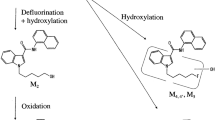Abstract
Purpose
Urine is the most suitable specimen to collect from individuals because of noninvasiveness and relatively large volumes obtainable. In authentic urine specimens, however, synthetic cannabinoids having the structures of quinolinyl ester indoles, such as 5F-PB-22, PB-22 and BB-22, in unchanged forms as well as their metabolites, have not been quantified yet. Therefore, the aim of this study was to establish a sensitive analytical method for the quantification of 5F-PB-22 and its three metabolites 5F-PB-22 3-carboxyindole, PB-22 N-5-hydroxypentyl and PB-22 N-pentanoic acid in authentic urine samples in four cases.
Methods
These compounds were extracted from β-glucuronide-hydrolyzed and unhydrolyzed urine via liquid-liquid extraction. The identification and quantification were performed using the QTRAP type of a liquid chromatography–tandem mass spectrometer.
Results
The limits of detection were 3–30 pg/mL and their summed quantitation range was 10–10,000 pg/mL. The devised method was applied to quantify these compounds in authentic urine specimens obtained from four individuals. The levels of 5F-PB-22 were 5.1, 13.6, 94.7 and 470 pg/mL; those of 5F-PB-22 3-carboxyindole were 8.25, 3.39, 23.2 and 880 ng/mL; and those of PB-22 N-pentanoic acid were 12.0, 57.4, 959 and 2090 pg/mL, respectively, in four unhydrolyzed urine samples, and the levels of PB-22 N-5-hydroxypentyl could be quantified as 29.9 and 131 pg/mL in two unhydrolyzed urine samples.
Conclusions
The 5F-PB-22 and its metabolites PB-22 N-5-hydroxypentyl have been detected from authentic human urine samples for the first time. Also, this is the first report dealing with the quantification of the three metabolites in human urine samples.



Similar content being viewed by others
References
Kaneko S (2017) Motor vehicle collisions caused by the ‘super-strength’ synthetic cannabinoids, MAM-2201, 5F-PB-22, 5F-AB-PINACA, 5F-AMB and 5F-ADB in Japan experienced from 2012 to 2014. Forensic Toxicol 35:244–251
Uchiyama N, Matsuda S, Kawamura M, Kikura-Hanajiri R, Goda Y (2014) Identification of two new-type designer drug, piperazine derivative MT-45 (I-C6) and synthetic peptide Noopept (GVS-111), with synthetic cannabinoid A-834735, cathinone derivative 4-methoxy-α-PVP, and phenethylamine derivative 4-methylbuphedrine from illegal products. Forensic Toxicol 32:9–18
Uchiyama N, Matsuda S, Kawamura M, Kikura-Hanajiri R, Goda Y (2013) Two new-type cannabimimetic quinolinyl carboxylates, QUPIC and QUCHIC, two new cannabimimetic carboxamide derivatives, ADB-FUBINACA and ADBICA, and five synthetic cannabinoids detected with a thiophene derivative α-PVT and an opioid receptor agonist AH-7921 identified in illegal products. Forensic Toxicol 31:223–240
Sobolevsky T, Prasolov I, Rodchenkov G (2010) Detection of JWH-018 metabolites in smoking mixture post-administration urine. Forensic Sci Int 200:141–147
Wohlfarth A, Gandhi AS, Pang S, Zhu M, Scheidweiler KB, Huestis MA (2014) Metabolism of synthetic cannabinoids PB-22 and its 5-fluoro analog, 5F-PB-22, by human hepatocyte incubation and high-resolution mass spectrometry. Anal Bioanal Chem 406:1763–1780
Tsujikawa K, Yamamuro T, Kuwayama K, Kanamori T, Iwata YT, Inoue H (2014) Thermal degradation of a new synthetic cannabinoid QUPIC during analysis by gas chromatography-mass spectrometry. Forensic Toxicol 32:201–207
Behonick G, Shanks KG, Firchau DJ, Mathur G, Lynch CF, Nashelsky M, Jskierny DJ, Meroueh C (2014) Four postmortem case reports with quantitative detection of the synthetic cannabinoid, 5F-PB-22. J Anal Toxicol 38:559–562
Schep LJ, Slaughter RJ, Hudson S, Place R, Watts M (2015) Delayed seizure-like activity following analytically confirmed use of previously unreported synthetic cannabinoid analogues. Hum Exp Toxicol 34:557–560
Abouchedid R, Ho JH, Hudson S, Dines A, Archer JRH, Wood DM, Dargan PI (2016) Acute toxicity associated with use of 5F-derivations of synthetic cannabinoid receptor agonists with analytical confirmation. J Med Toxcol 12:396–401
Takayama T, Suzuki M, Todoroki K, Inoue K, Min JZ, Kikura-Hanajiri R, Goda Y, Toyo’oka T (2014) UPLC/ESI-MS/MS-based determination of metabolism of several new illicit drugs, ADB-FUBINACA, AB-FUBINACA, AB-PINACA, QUPIC, 5F-QUPIC and α-PVT, by human liver microsome. Biomed Chromatogr 28:831–838
Diao X, Carlier J, Zhu M, Pang S, Kronstrand R, Scheidweiler KB, Huestis MA (2017) In vitro and in vivo human metabolism of a new synthetic cannabinoid NM-2201 (CBL-2201). Forensic Toxicol 35:20–32
Minakata K, Yamagishi I, Nozawa H, Hasegawa K, Suzuki M, Gonmori K, Suzuki O, Watanabe K (2017) Sensitive identification and quantitation of parent forms of six synthetic cannabinoids in urine samples of human cadavers by liquid chromatography-tandem mass spectrometry. Forensic Toxicol 35:275–283
Acknowledgements
This work was supported by JSPS KAKENHI Grant number JP16K09206.
Author information
Authors and Affiliations
Corresponding author
Ethics declarations
Conflict of interest
The authors declare that there are no financial or other relationships that could lead to a conflict of interest.
Ethical approval
All procedures performed in this study involving human participants were in accordance with the ethical standards of the international and/or national committee and with the 1964 Declaration of Helsinki and its later amendments or comparable ethical standards. Informed consent was obtained from all participants included in the study, who supplied about 40 mL each of urine for use as blank samples. The analysis of toxic substances from the authentic human urine samples was permitted by judicial authorities and supported by official documentation.
Rights and permissions
About this article
Cite this article
Minakata, K., Hasegawa, K., Yamagishi, I. et al. Sensitive quantification of 5F-PB-22 and its three metabolites 5F-PB-22 3-carboxyindole, B-22 N-5-hydroxypentyl and PB-22 N-pentanoic acid in authentic urine specimens obtained from four individuals by liquid chromatography–tandem mass spectrometry. Forensic Toxicol 36, 151–159 (2018). https://doi.org/10.1007/s11419-017-0395-4
Received:
Accepted:
Published:
Issue Date:
DOI: https://doi.org/10.1007/s11419-017-0395-4




